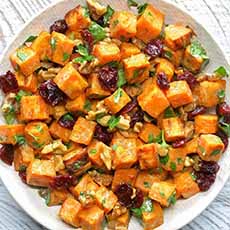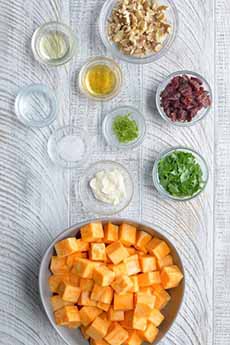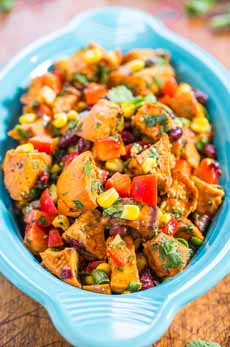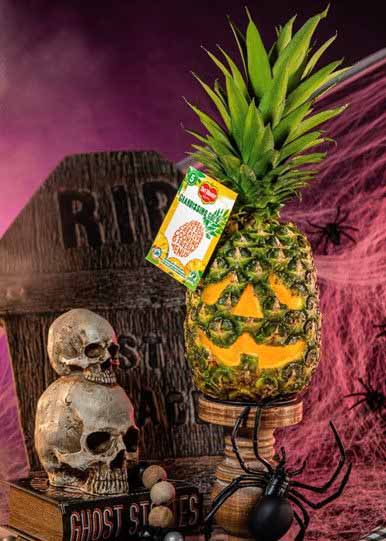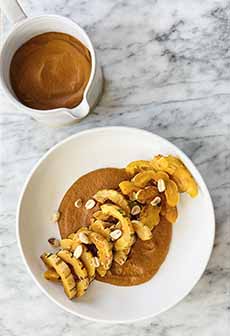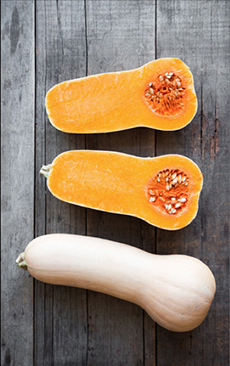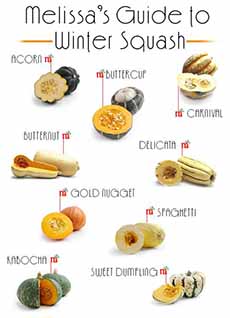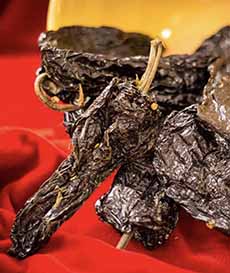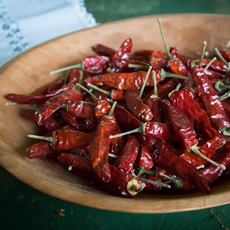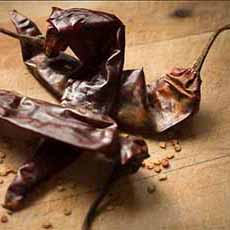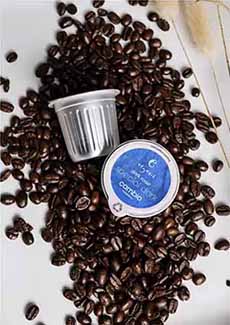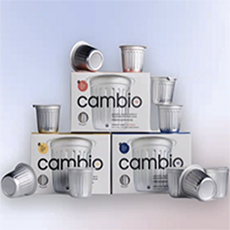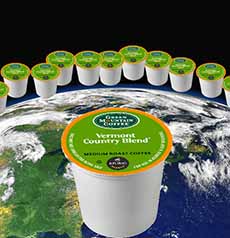|
This year, the Jewish New Year, Rosh Hashanah, begins October 2nd at sundown*. A traditional part of the festival’s dinner is kugel (KOO-gull), a casserole-like (or baked pudding-like) side that is served as part of the main course.
The name means, simply enough, “head (i.e. beginning) of the year.”
Kugel, in Yiddish, is a baked casserole, also called a “pudding,” most commonly made from egg noodles or potatoes. It is a traditional Ashkenazi‡‡ Jewish dish, a baked pudding often served as a side dish on the sabbath and Jewish holidays.
You don’t have to be Jewish or a celebrant of any holiday to enjoy a good kugel, warm from the oven or at room temperature. Kugel is comfort food for any time.
Our Nana’s kugel was a classic noodle kugel or noodle pudding (lokshen kugel in Yiddish), a combination of extra-wide egg noodles, cream cheese and/or cottage cheese, raisins, apples, cinnamon, sugar and vanilla—with optional sliced almonds.
> Here’s her kugel recipe. As a kid with a sweet tooth, we couldn’t get enough of it.
The most popular traditional savory kugel is potato kugel, made of shredded potatoes and onions.
But with an eye toward healthier eating, mixed vegetable kugels have become very popular in recent decades. There are more kugel recipes below.
> The history of kugel.
> More favorite Passover recipes are below.
TYPES OF KUGEL
As with many dishes, there are as many types of kugel as there are cooks who conceive them.
You may even have enjoyed kugel without knowing it: Baked rice pudding is a kugel (rice kugel). Carrot pudding (a side dish that evolved into dessert—carrot cake—in the 20th century) is a kugel.
Sweet kugels tend to include fresh or dried fruit, as well as sugar. Beyond the traditional apple and/or raisin kugel, they can be made with butternut squash, cherries or other berries, peaches, pineapple, rhubarb, and dried fruits.
If you have a guest list of adventurous foodies, consider fall fruits like goji, honeyberry, pawpaw, persimmon, rambutan, or starfruit (carambola).
While carrots, corn, and sweet potatoes are not fruits, they are made into sweet kugels as well as savory kugels.
Savory kugels were traditionally potato kugels with a touch of onion, but broccoli, cabbage, carrots, cheese (anything, from Emmental to Parmesan), spinach, yellow squash, and zucchini have become popular.
Like cauliflower and mushrooms? Put them in your kugel. Check out the savory kugel recipes on Pinterest, where we found this garlic farfel kugel from All Recipes!
Whether sweet or savory, go modern by adding your favorite herbs and spices.
We like cardamom or pumpkin pie spices in a sweet kugel, caraway, dill, or roasted garlic in a savory kugel.
Love crushed red pepper and chili powder? Use them—or fresh jalapeño slices—in your kugel.
Today’s featured recipe is a savory kugel created by Hannah Kaminsky of Bittersweet Blog, which focuses on vegan fare.
It’s not only savory, it’s vegan, dairy-free, gluten-free, and low-carb, made with spiralized zucchini noodles.
“Silky stands of spiralized zucchini ribbons elevate the conventional noodle kugel to all new heights,” says Hannah. “Vegan, gluten-free, and kosher, it’s a more savory take on the dish that everyone will crave.”
RECIPE: ZOODLE KUGEL INSTEAD OF NOODLE KUGEL: VEGAN & SAVORY
Hannah made this kugel a vegan recipe with vegan sour cream and nutritional yeast instead of cheese.
We used regular sour cream and Parmesan.
This recipe finds a place between tradition and innovation. You can add whatever you like: caramelized onions, garlicky mushrooms, thinly shaved fennel, fresh dill, and roasted red peppers or sun-dried tomatoes. The possibilities are endless.
Prep time is 20 minutes, cook time is 60 minutes, additional time is 15 minutes.
Ingredients
2 pounds zucchini (about 4 medium—for more color, you can mix green and yellow squash)
1 teaspoon salt, divided
1 medium yellow onion
2 cloves garlic, minced
1 cup cooked white beans
1/4 cup tahini
1/4 cup tapioca flour
2 tablespoons grated Parmesan or nutritional yeast‡
1 tablespoon Lemon Juice
1/4 cup olive oil
1/3 cup vegetable stock
1/4 teaspoon freshly-ground black pepper
Optional: sour cream
|
|
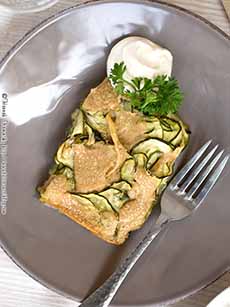
[1] Zoodle kugel: zucchini kugel with a dab of sour cream (photos #1, #2, and #3 © Hannah Kaminsky | Bittersweet Blog).
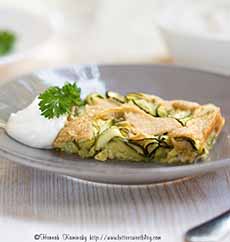
[2] The side view of this velvety kugel.

[3] Before or after the main course, you can serve a separate “kugel course” with a green salad.
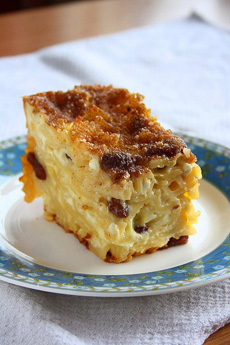
[4] A classic noodle kugel with raisins. Here’s the recipe (photo © Collecting Memories | Blogspot).
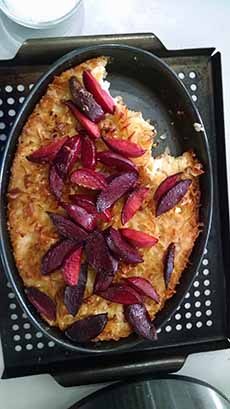
[5] Recipe in The Gefilteria Manifesto (photo © Flatiron Books).
|
Preparation
1. PREHEAT the oven to 350°F and lightly grease a 13 x 9-inch (or 3-quart) baking dish.
2. SPIRALIZE the zucchini using the wide ribbon slicing blade, creating long noodle-like strands of zucchini (“zoodles”). Toss with 1/2 teaspoon of salt and let stand for 10 minutes.
2. DRAIN the excess water, gently pressing down on the zucchini to get out as much liquid as possible. Gently blot with a clean kitchen towel to further dry. Toss with the onion and garlic, and set aside.
3. PLACE the white beans, tahini, tapioca flour, Parmesan/nutritional yeast, lemon juice, olive oil, and vegetable stock in a blender or food processor. Purée until completely smooth, pausing to scrape down the sides of the bowl as needed to incorporate everything.
4. TRANSFER the vegetables to the prepared baking dish, spreading them out in an even layer. Pour the bean purée all over, using a spatula to smooth it out. Tap the whole pan on the counter several times so that the batter falls down in between the zucchini noodles.
5. BAKE for 50-60 minutes, until golden brown on top. Let cool for at least 15 minutes before serving.
6. GARNISH with a dollop of sour cream or Greek yogurt, if desired.
MORE KUGEL RECIPES
> Chocolate Cappuccino Noodle Kuge recipel, great for breakfast.
> Matzoh Kugel Recipe
MORE ROSH HASHANAH RECIPES
With Pre-Dinner Drinks
Chutney-honey dip with apples
Chopped Chicken Liver Crostini
Soup, Mains, & Sides
Buttermilk Roast Chicken
Potato Latkes & Other Root Vegetable Latkes
Chopped Fennel & Apple Salad
Potato, Onion, & Cauliflower Latkes
Chicken & Matzo Ball Soup
Desserts
Dried Fruit Tart
Easy Apple Cake
Easy Apple Crisp
________________
*In the Hebrew calendar, it is held on the first day of the Hebrew month of Tishri, and the first of the Jewish High Holy Days specified by Leviticus 23:23–25. It is marked by the blowing of the shofar, and begins the ten days of penitence culminating in Yom Kippur. Rosh Hashanah is followed by Yom Kippur, Sukkot, Simchat Torah, Chanukah, Purim, Passover, Shavuot, completing the year. This year, the Hebrew year 5725 begins at sunset on October 1, 2024. Here’s how to convert dates in the Hebrew calendar to the Gregorian calendar.
†A shofar is an ancient musical instrument used for Jewish religious purposes. It is blown during synagogue services on Rosh Hashanah and at the end of Yom Kippur. The instrument typically is made from a ram’s horn. Like the modern bugle, the shofar lacks a pitch-altering device. All pitch control done by the player’s varying the placement of his mouth (embouchure) to the mouthpiece.
‡A shofar is an ancient musical instrument used for Jewish religious purposes. It is blown during ‡Nutritional yeast is a plant-based substitute with a flavor that’s savory, cheesy, and nutty. It often substitutes for cheese in vegan dishes.
‡‡Ashkenazi is one of two major ancestral groups of Jewish people whose ancestors lived in France and Central and Eastern Europe, including Germany, Poland, and Russia. The other group is called Sephardic, and includes those whose ancestors lived in Spain, Portugal, North Africa, and the Middle East. Understandably, their cuisines were different, based on local ingredients and traditions.
CHECK OUT WHAT’S HAPPENING ON OUR HOME PAGE, THENIBBLE.COM.
|
